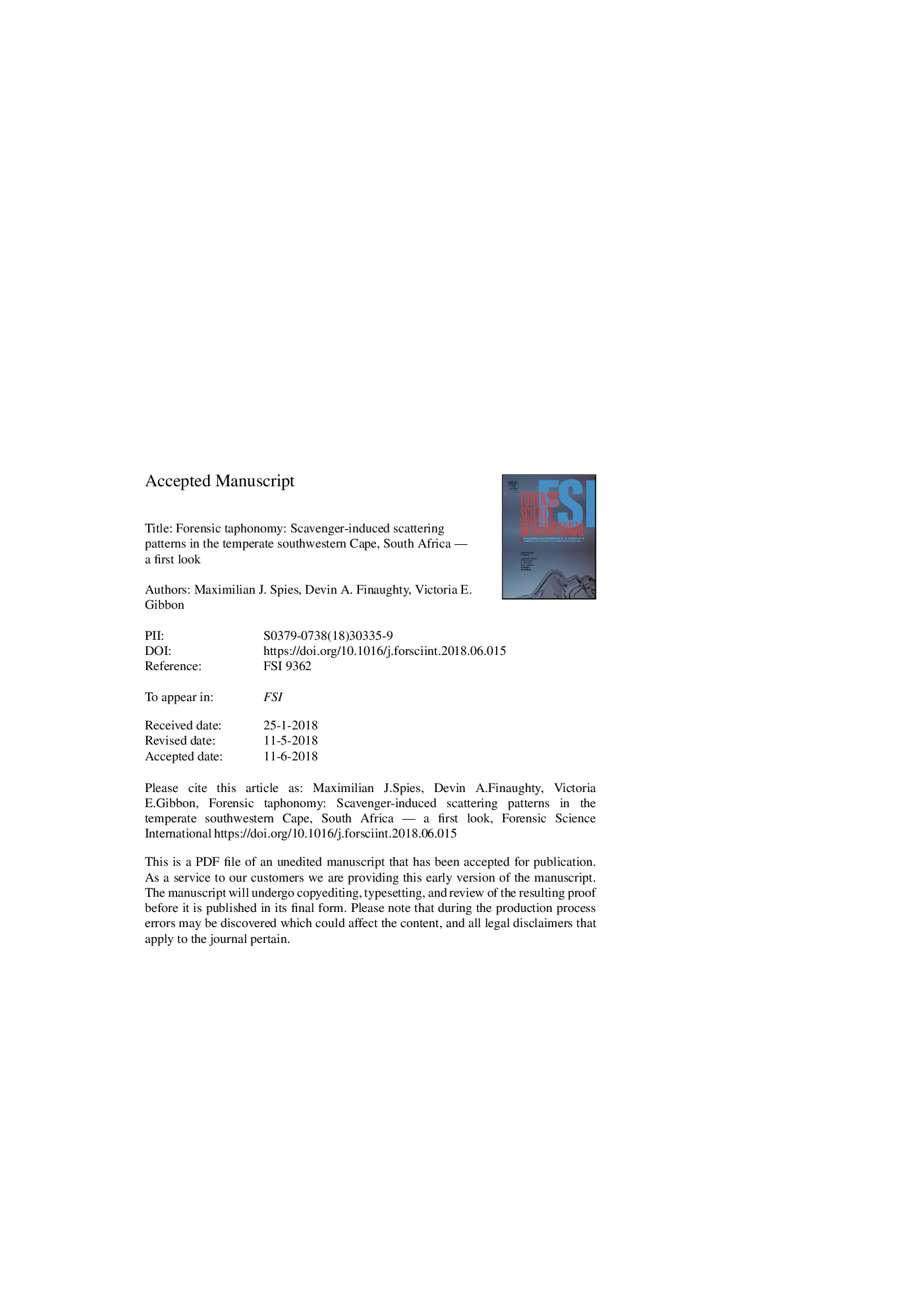| کد مقاله | کد نشریه | سال انتشار | مقاله انگلیسی | نسخه تمام متن |
|---|---|---|---|---|
| 6550736 | 1421960 | 2018 | 19 صفحه PDF | دانلود رایگان |
عنوان انگلیسی مقاله ISI
Forensic taphonomy: Scavenger-induced scattering patterns in the temperate southwestern Cape, South Africa - A first look
دانلود مقاله + سفارش ترجمه
دانلود مقاله ISI انگلیسی
رایگان برای ایرانیان
کلمات کلیدی
موضوعات مرتبط
مهندسی و علوم پایه
شیمی
شیمی آنالیزی یا شیمی تجزیه
پیش نمایش صفحه اول مقاله

چکیده انگلیسی
The effect of vertebrate scavenging can drastically alter the rate of decomposition and cause skeletal scatter, which hinders human forensic recovery and identification. Patterns of scavenging, disarticulation and scatter in a forensic context are specific to different environments with no known data for South Africa. A better understanding of these patterns can increase the chances of full body recovery and improve identification of human remains. In this preliminary study, the effect of wild vertebrate scavenging on skeletal scatter was examined using a porcine model in the forensically significant thicketed Cape Flats Dune Strandveld habitat. This area is a densely populated part of Cape Town, which suffers from poor socioeconomic conditions and a high murder rate. Ethics was granted for the use of three small (â¼20Â kg) domestic pig (Sus scrofa domesticus) carcasses as proxies for human decomposition. They were deployed in Delft, Cape Town, and observed by motion-activated cameras to record wild scavenger activity. One pig served as a control and was caged to prevent vertebrate but not invertebrate access; the other two served as experimental treatments. Scatter was recorded every second day by marking the location of skeletal elements and measuring the distance and angle from the centre of each deposition site. No scattering was observed in the control, but notable scattering patterns were observed in the experimental pigs due to Cape grey mongoose (Galerella pulverulenta) scavenging, the only vertebrate scavenger species observed. No clear pattern of scatter distance over time was followed. Scatter began in the skeletonisation phase (day 25-30), resulting in a maximum distance of 12.67Â m and scatter/search area of 504.32Â m2. Mongoose-induced skeletal scatter followed a distinct pattern of movement into dense undergrowth, a previously unobserved behaviour and a key finding of this study. These results provide baseline data for sub-adult human scatter, or scatter of smaller components of an adult human skeleton, as demonstrated in the forensic case example provided. Knowledge is provided on locally relevant decomposition patterns and informs search methods for improved human skeletal recovery in forensic cases. There is scope for expansion of this study, with an investigation of seasonal effects, the interaction between invertebrate and vertebrate activity, as well as, the effect of clothing on scavenger access.
ناشر
Database: Elsevier - ScienceDirect (ساینس دایرکت)
Journal: Forensic Science International - Volume 290, September 2018, Pages 29-35
Journal: Forensic Science International - Volume 290, September 2018, Pages 29-35
نویسندگان
Maximilian J. Spies, Devin A. Finaughty, Victoria E. Gibbon,